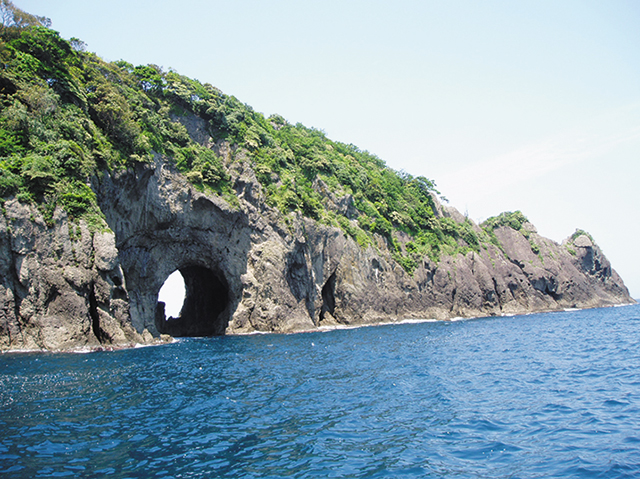- MOE
- National Parks of Japan
- San'inkaigan National Park
- Guide of Highlights
main body
Highlights of San'inkaigan National Park
Tottori Sand Dunes

Tottori Sand Dunes
Measuring 16 km east-west and 2.4 km north-south the Tottori Sand Dunes are Japan's largest sand dunes. The dunes were formed by sand flowing down from the Chugoku Mountains, carried by rivers and ocean winds, which then shaped the sand into dunes. Here beautiful patterns created by the sand and wind (wind ripples) and bowl-shaped depressions can be seen, and this unique, richly varying and undulating topography is one of the attractions of the Tottori Sand Dunes.
Sengan-Matsushima Island

Sengan-Matsushima Island
This small granite island can be found floating in the ocean immediately north of Ajiro Port. During the Kanbun Era (approx. 300 years ago), there was a magnificent pine tree growing at the top of the rock, and legend has it that Ikeda Tsunakiyo, the Second Lord of the Tottori Domain, decreed that "Whosoever moves this pine with the rock attached to my garden shall receive 1,000 kan ("sen-gan") of silver", and this is how the island is said to have gotten its name.
Kamogaiso Beach

Kamogaiso Beach
Kamogaiso is the collective name for three beaches: in order from west, Kokamogaiso, Tsubakidani, and Okamogaiso. Numerous islets float in the complex cove, while on the beach, large grains of quartzose sand sparkle like crystal.
Natane Goto Islands

Natane Goto Islands
These five connecting islands are located on the Shirawara Beach. At the tip is Natanejima Island, which has a circumference of approx. 400 m and a height of approx. 60 m. In spring, wildflowers decorate the island a vivid yellow.
Ryujin-do Cave

Ryujin-do Cave
These caves were created through wave erosion along faults in the rock. The caves are divided into two--East Cave (Kairyujin) and West Cave (Okaryujin); house martins build nests in the walls, and greater horseshoe bats live inside the caves.
Anami Beach

Anami Beach
Created through the erosion of andesite formed at the time the Japan Sea was formed, this rocky shore is dotted with tiny islands, including meotoiwa ("husband-wife rock") pairs. Rhyolite dikes with numerous bale-shaped columnar joints form promontories and islets.
Ryugu Sea Cave

Ryugu Sea Cave Viewing from Ocean
Ryugu Sea Cave
The cave gained its name because the andesite dike below appears to be climbing the granite walls to the sky like a dragon (ryu), while a cave (domon) was also carved out of the andesite.
Mio-Oshima Island

Mio-Oshima Island
An island created by magna hardening into a hexagonal shape with a large amount of columnar jointing, the countless columnar joints and clear tabular joints on the island's southeastern side present an especially beautiful landscape.
Asahi Sea Cave

Asahi Sea Cave Viewing from Ocean
Asahi Sea Cave
This cave tunnel is located in the center of the Cape Nokogiri. It was named because of the beautiful sight of the morning sun (asahi) shining through the tunnel.
Kujaku Tunnel

Kujaku Tunnel
This cave was formed through the partial wave erosion of columnar and tabular joints. The cave was named the Kujaku (Peacock) cave because it looks like a peacock with its tail feather spread into a fan.
Imago-ura Beach

Imago-ura Beach
A cove where a reef called Senjojiki ("flat like 1,000 tatami mats") lies side-by-side with a white sandy beach, Imagoura is an excellent place to enjoy swimming or camping. It is also called Kaeru-jima Island ("Frog Island" because of its shape, and various unique landforms can also be seen here, such as Shiraishijima Island, which has an unusual shape reminiscent of the sole of someone's foot or jewels.
Hasakari-iwa Rocks

Hasakari-iwa Rocks
Located on the shoreline of the Takeno Beach in an area of wave-cut cliffs, this landform is a rock gate formed along conglomerate strata. The rock forming the roof of a sea cave is thought to have fallen and stuck between the cave walls. The site is designated by Hyogo Prefecture as a Place of Scenic Beauty.
Takeno Beach

Takeno Beach
A shoaling beach approx. 800 m in length, Takeno Beach has been selected as one of Japan's Top 100 Bathing Beaches due to the high transparency of the water here. It has also ranked in Japan's Top 100 Waves, Japan's Top 55 Bathing Beaches, and Japan's Top 88 Bathing Beaches, making it one of Japan's representative bathing beaches.
Shotenkyo

Shotenkyo
A beautiful dune area dividing Kumi-hama Bay from the Sea of Japan, Shotenkyo has been selected as one of Kyoto's Top 200 nature sites. The area came to be called Shotenkyo ("Little Bridge to Heaven") because of its similar shape to the Amanohashi-date ("Bridge to Heaven") sandbar.
Tango Sand Dunes

Tango Sand Dunes
These sand dunes stretching approx. 6.5 km from Shotenkyo to near the mouth of the Kizugawa River are a popular and lively swimming spot during summer. Also, rare seaside plants such as Pseudolysimachion ornatum, grow naturally in the sand dunes.
Goshiki Beach

Goshiki Beach
Wave-cut benches can be seen along this rocky shoreline. In tidal pools and potholes in the benches, it is possible to observe ocean creatures. The beach got the name Goshiki ("Five Colors") Beach because of the various different colors of the pebbles there.
Wildlife & Plants
Pseudolysimachion omatum

Pseudolysimachion omatum
A perennial plant found along the Japan Sea Coast. Blooms in August and September with beautiful, small flowers. Seen throughout the Tango Sand Dunes.
Calystegia soldanella

Calystegia soldanella
This is a beach plant that is found in the sandy soil of coastal and lakeside areas,
and grows along the ground. From about May to June, it blooms trumpet-shaped pink flowers.
Hypselodris festiva

Hypselodris festiva
A mollusk distinguished by an overall blue color with a yellow spotted pattern. Found in tidal pools and reefs. Hypselodoris festiva and a wide variety of other colorful sea slugs can be observed during the snorkelling lessons and seashore nature observation courses held by the Takeno Snorkelling Center.
Oriental White Stork (Ciconia boyciana)

Oriental White Stork (Ciconia boyciana)
Found throughout East Asia, the original Japanese specimens are now extinct in the wild. Reintroduction is currently underway centered round Toyooka City in Hyogo Prefecture to assist recovery of the Japanese population. A reintroduced population can be seen in the vicinity of the Maruyama River.

